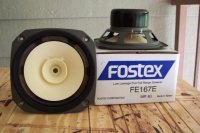
The requirements were to use a Fostex FE167E in a transmission line cabinet, with the driver 36" off of the floor and with a slot port. Simple enough, except that the FE167E has too low a Qts (.308 spec) and too high a Vas (36 liters spec). When I got the actual samples, I measured the Qts as .36 and Vas at 32 liters. Better. For a 6" driver, I like to see Qts ~.45 and Vas ~15 liters when used in TL's. But, sometimes strange things happen, so I fired up Martin King's MathCAD worksheets and gave it a go.
I usually find that a low Q driver works best in an untapered pipe. After fiddling around with the model for a while, I found that I got reasonable results with a pipe area of 4*Sd, a length of 45" and a port of 9"x1 1/2"x4 3/4". The most interesting graphs from the model simulation:
Unstuffed Pipe

Combined(Red) and Infinite Baffle(Blue) Frequency Response

Driver(Red) and Port(Blue) Frequency Response
Actual measurements of completed unstuffed cabinet
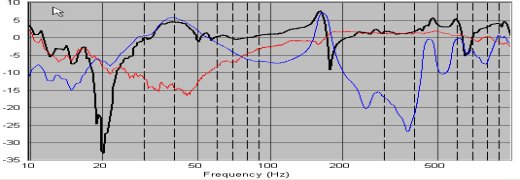
Combined(Black),Driver(Red) and Port(Blue) Frequency Response
Stuffed Pipe

Combined(Red) and Infinite Baffle(Blue) Frequency Response

Driver(Red) and Port(Blue) Frequency Response
Actual measurements of completed stuffed cabinet
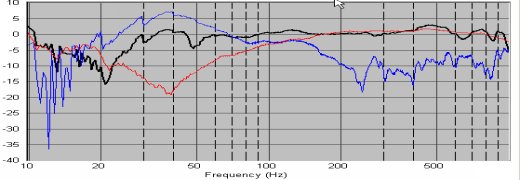
Combined(Black), Driver(Red) and Port(Blue) Frequency Response
The original FT-1600's met all expectations. They do not go quite as deep as the "Peerless Pipes", but they go deep enough. D=37Hz is loud and clear. C=32Hz is there, if a little weak and woolly. But the mids and highs are to die for. The Fostex drivers have as good detail as anything short of the exotic metal drivers, and there are no phasing problems around the cross-over, since, well, there IS no cross-over! If you were ever considering a full-range project, start here.
While the SPL falls off below 100Hz, it is pretty much in lock-step with what is expected for room-lift. The peak at 40Hz doesn't seem to be a problem, particularly since it is below almost all music.These speakers need contouring. The simplest method is to use a half-octave equalizer. That's what my buyer is doing with her set. Some audiophiles foam at the mouth, get white in the face and tremble a lot at the thought of any equalization. (Must remain pure, must remain pure!) OK, the next best approach is the filter I describe here. This is the standard zobel and series Baffle Step Correction circuit. I copied the BSC circuit from my "Straight Pipes" and present it here. This works just fine. Adjust the resistor to get the amount of BSC you need. The penalty is reduction in efficiency by the amount of BSC. A 4 ohm resistor reduces the SPL to 92dB/w/m.
The MkII version is an evolutionary improvement upon the original design. Over the three years since I published the original FT-1600, I have tried to improve the mid-range presence by reducing the amount of stuffing in the cabinet and at the same time, reduce the amount of ripple in the upper bass/low mid-range area. This was accomplished by reducing the cabinet height by 3 1/2" and adjusting the driver and port positions. It was necessary to abandon the slot port at the bottom of the baffle in favor of a round port 4 1/2" up from the bottom. The re-sizing and rearrangement of the cabinet was so successful that there is now no stuffing in the cabinet whatsoever. The only damping inside the cabinet is 1/2" of yellow acoustic fiberglass applied to all sides and the top. The internal cabinet dimensions are now 40" x 8 1/2" x 8 1/2".
Cabinet with slot port at bottom

Combined(Red) and Infinite Baffle(Blue) Frequency Response

Driver(Red) and Port(Blue) Frequency Response
Cabinet with round port 4" up from bottom

Combined(Red) and Infinite Baffle(Blue) Frequency Response

Driver(Red) and Port(Blue) Frequency Response
Actual measurements of ported and lined cabinet
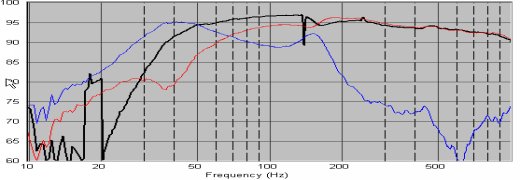
Combined(Black), Driver(Red) and Port(Blue) Frequency Response
Lining a Mass-Loaded TL as opposed to stuffing it poses a real problem as far as modeling the results. As you can see from the actual measurements, the lined cabinet is somewhat over-damped. The bottom end is now rounded off, but the F10 point remains the same. This means that it is unlikely that the speaker will boom at the bottom. The falling response with rising frequency may well be real, but as is shown in the far-field measurements, is swamped by the baffle hump effect. (Baffle hump is a rise in output in the octave surrounding the half-wave width of the cabinet.
The contour filter is much simplified. I found that by eliminating the zobel, I could get an acceptable response by simply putting a 1.5mH inductor paralleled with a 4ohm resistor in the hot lead. (You will want to try different resistor values. wiring the low side of an L-pad across the inductor is a good way to try 0-8ohms, or the high side for larger values.) Adding series resistance will bring down the upper end of the response. This is automatic with SET amps, and adding resistance to SS amps will give you some of the "Tube" sound.
FT-1600 MkII Contour Filter
FT-1600 MkII Far-field Response
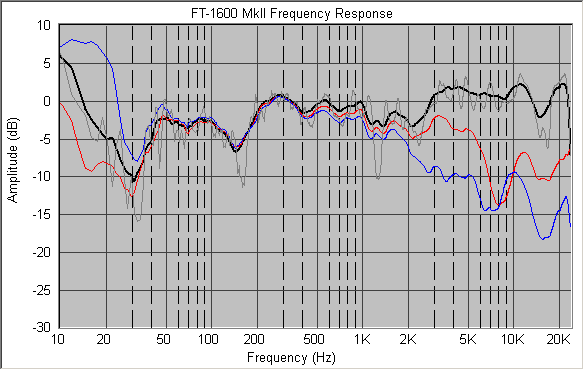
On Axis(Black), 30oOff axis(Red) and 60oOff axis(Blue) Frequency Response
I have cheated a little on the presentation, just like every other builder and driver manufacturer. The data is smoothed at 1/2 octave and the dynamic range is expanded to a needlessly high value. However, just to assure you that I am not hiding anything, the gray curve is the unsmoothed on-axis frequency response. The dip at 158Hz is floor bounce, and will increase in frequency and decrease in depth as the listening position is moved back. The dip at 1244Hz is reflection off of the driver surround, a feature of virtually all cone drivers.
Bottom line: The on axis frequency response is +/-3dB 41-22,000Hz and -/+10dB 32-24,000Hz. The FT-1600 MkII is superb for its intended use; female voice, small group jazz and classical. There is a noticeable improvement in the smoothness of the upper bass and midrange. The sound is open and airy. I like 'em.
Back to FT-1600 MkII Main Page
Products Articles Design Philosophy Contact
